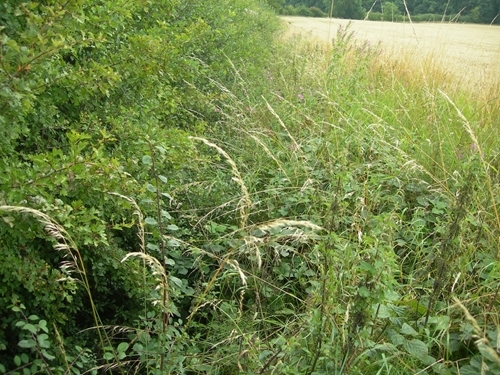A new book, The Ecology of Hedgerows and Field Margins published this month sheds new light on the network of hedges, ditches and grass margins that form an integral part of the landscape across most of lowland Britain. Once serving an important livestock control function in farming systems, field margins subsequently became valued for their wildlife. As such, they were regarded as almost independent of the farmed land each side of them, a linear oasis in an environment in which the fortunes of wildife had taken a substantial turn for the worse. As field margins were defined almost exclusively as hedges, and the quality of those hedges for both wildife conservation and livestock containment had declined, the emphasis was on their management as a habitat for wildlife.

Field margin at Loddington, comprising hedge, ditch and herbaceous vegetation
The book brings together research results that contribute to more enlightened management of hedges for wildlife. But field margins are once again more than hedges. As well as ditches, they include a range of habitats, specifically designed to benefit wildlife, features that are relatively new to the farmed environment. They provide an example of how our landscapes continue to evolve in reponse to our developing knowledge, values and requirements. Increasingly, and importantly, they are recognised as being an integral part of the wider landscape. Many bird species nesting in hedges gather their food from the adjacent farmland, or from land managed for wildlife in field margins for example.
And increasingly, there are demonstrable benefits of field margins to food production in the adjacent fields. Chapters cover beneficial invertebrate predators of crop pests for example, and the role of field margins in supporting pollinating insects which contribute to the pollination of oilseed rape and field beans, as well as fruit trees, soft fruit and hedgerow shrubs.
In my own chapter, I provide a summary of the relevant research that has been carried out at Loddington over the years, including that on field margin wildlife which has its own intrinsic (non-monetary) value. But there are also the ground and rove beetles, spiders, bumblebees, solitary bees, earthworms and others for which field margins play a crucial role, and which also influence our ability to produce food from the land. Not 'just' wildlife, but an essential part of our own ecology. As our understanding of them continues to grow, the importance of field margins in our lowland landscapes becomes increasingly apparent.
The Ecology of Hedgerows and Field Margins is now available in the GWCT Shop.

Buy Now >>